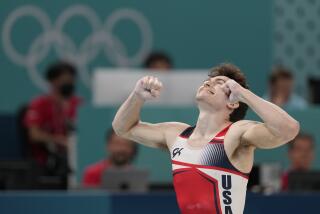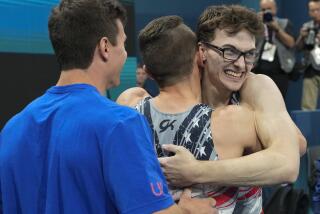A LOOK AT THE OTHER SPORTS...
- Share via
Los Angeles afforded American equestrians their finest Olympic hour. They rode away with three gold medals--two team, one individual--and two individual silvers.
It was the best performance ever for U.S. riders in an Olympics, and it will affect equestrian sports in this country for years, probably decades.
“It will take several years to really be able to evaluate it,” Bill Steinkraus, United States Equestrian Team (USET) chairman, said recently. “It’s like a baby boom. You don’t feel the results immediately. You see them in years to come.”
But Steinkraus, who won an individual gold medal in show jumping during the 1968 Olympics in Mexico, does believe that the strong showing of U.S. riders in the Olympic events at Santa Anita had an immediate effect on young riders from the East Coast to the West in all three of the equestrian disciplines--show jumping, dressage and the three-day event.
“We already had a horse explosion in the country before the Games, especially among the younger people,” he said. “The Games, if anything, accelerated that trend. There was a generation turned on by what happened in Los Angeles. A lot of interest was developed. The fallout--the way you’ll see it--is mostly in the kids.”
Winners of both individual and team gold medals in Los Angeles, the U.S. show jumpers, said Steinkraus, remain the discipline with the most depth, able to field not one, but two nearly equal international teams.
“There’s still not quite as much depth in three-day, but its coming,” Steinkraus said, even though the ’84 U.S. three-day team took the gold medal, and team member Karen Stives won an individual silver medal.
“We’re even coming along in dressage,” he said. “Over the next few years, you’ll see it. Reiner Klimke (West Germany’s individual dressage gold medalist) was here this spring to conduct two clinics and he said he could see the light at the end of the tunnel for us.”
Steinkraus and other officials of the USET are disappointed that they have not been able to generate more nationwide interest in televising equestrian events since the Los Angeles Olympics. Coverage of equestrian competitions has increased this year on cable TV, but not on the networks. ESPN is broadcasting 10 of the 31 horse shows included in the Grand Prix circuit this season; CBN (Christian Broadcasting Network) will televise about 10 additional horse shows on cable during 1985.
The United States won the team championship at Aachen, West Germany last month with a squad made up of Joe Fargis, Olympic gold medalist in individual and team; Conrad Homfeld, silver individual winner and a member of the gold medal team; Louis Jacobs and Christian Currey, who did not compete in last year’s Games.
The U.S. encore to ’84 will come in 1988 at the Olympics in Seoul, South Korea, providing that problems can be worked out for the equestrian competitions.
There are currently horse quarantine difficulties in South Korea, but they are unlike those of the 1956 Olympics, when the rest of the events were held in Melbourne and the equestrian competitions in Stockholm. The 1956 problem was Australia’s strict six-month quarantine on horses coming into its country.
The 1988 situation is “exactly contrary,” according to Max Ammann, an FEI director from Bern, Switzerland. “The problem is not Korea. It’s the big horse racing countries, the U.S., France, Great Britain. They don’t want to let the horses back in (if they go to Korea to compete).
“Korea has a very small horse population, and not even the Korean government knew if they had any horse diseases,” Ammann said. “Once a (horse) disease breaks out, it moves very fast. That’s what the racing countries are concerned about. They want to protect the horses. But the Koreans have done surveys over the last 12 months and made a report (to the FEI). We feel things will be worked out and will be approved.”
More to Read
Go beyond the scoreboard
Get the latest on L.A.'s teams in the daily Sports Report newsletter.
You may occasionally receive promotional content from the Los Angeles Times.







